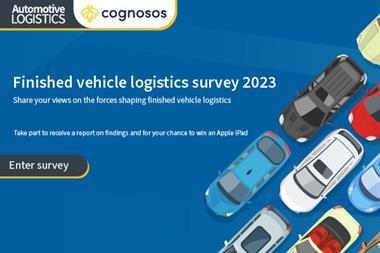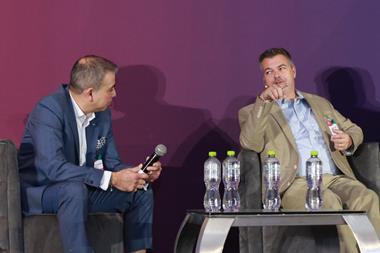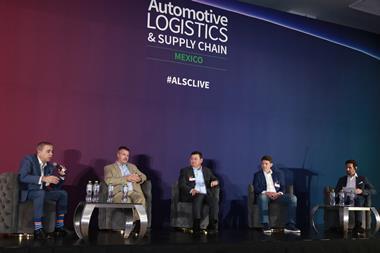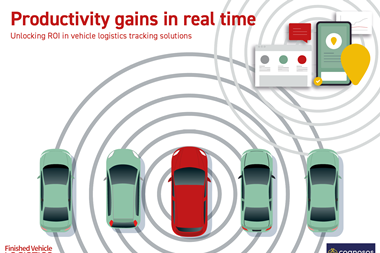PARTNER CONTENT
This content was paid for by Cognosos and produced in partnership with Automotive Logistics
Every company in the automotive logistics sector has a goal to cut the time and effort it takes to get vehicles through the supply chain and into the hands of the end user. Inbound logistics has been using tracking tech to speed up this process, but Cognosos says finished vehicle logistics is catching up – and could be set to overtake it.

The finished vehicle logistics market has had a tough few years following the pandemic. As the market recovers, it is struggling with lead times due to issues in rail and ro-ro, as well as labour shortages and capacity shortages affecting consistency in logistics operations. Having more visibility over the logistics and supply chain could help the sector to plan more effectively, improve efficiency and increase quality, and asset-tracking software provider Cognosos believes it has the tools to help the industry recover smoothly.
Cognosos recently unveiled its new Driver Tag to deliver even more visibility throughout the outbound logistics supply chain, which could help speed up delivery times and increase return on investment (ROI). The Driver Tag offers visibility into driver activity throughout the outbound logistics chain, including time spent moving vehicles and reducing damage risk by improving accountability. The product can then feed this data back to OEMs, vehicle processing centres (VPCs) and third-party logistics providers (3PLs). Cognosos also offers the fourth generation of its FVL tags, the RT-270, which eliminates the guesswork of locating vehicles that are ready for delivery. Using low-energy Bluetooth, the tag’s SpotLight feature uses LED lights on the vehicles that can flash and signal where they’re located.
Adrian Jennings, chief product officer at Cognosos, says both the Driver Tag and RT-270 Vehicle Tag will cut down delivery times and increase visibility, particularly when used together. “The Driver Tag is another way to leverage the Bluetooth technology that’s now in the Vehicle Tag,” he says. “The transparency is then obvious on both sides.”
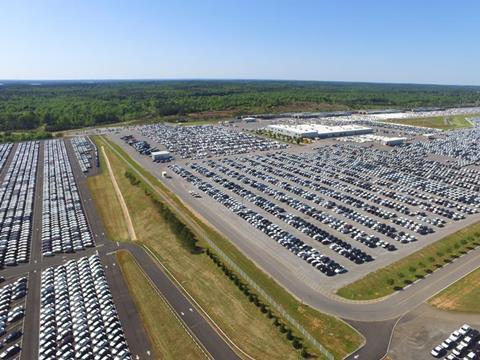
Driving efficiency and accountability
Going through the outbound FVL process, Jennings says the Driver Tag will help manage the movement of vehicles on a yard or to wherever they’re being held in storage. The driver moving the vehicle wears a tag which is a Bluetooth beacon on a lanyard or a clip. Once the car starts moving, the Vehicle Tag’s motion sensor scans for the Driver Tag to identify the driver. It also continues to scan for the driver when the car stops, so it can record when the driver left the vehicle.
This part of the automotive supply chain is relatively unmonitored, according to Jennings. “Nobody knows how efficient or inefficient the car moving process is,” he says. “How long is it taking different drivers to make the moves? How quickly after finishing the move do they get out of the car and move on to the next job? None of that information is currently available, so there’s no way to improve efficiency because there’s absolutely no visibility into what the efficiency today is.”
As well as providing this information necessary to improve efficiency, he says that the Driver Tag can increase accountability in the case of accidental damage occurring to the vehicles. Jennings says: “Vehicles do get damaged out in the yard, and we need to understand who was driving the car when it got damaged. Was it the OEM, or the shipper, or the 3PL or the carrier that damaged it? That’s an important financial metric, knowing who is on the hook for the repair. And for the drivers, just knowing that visibility is there causes people to take more care.”
High value, low cost
“In a perfect world, you would have a tracking system that told you the exact location of a vehicle, and while those solutions can be done, they are costly and difficult to deploy and maintain,” says Jennings. “Cognosos’s mantra has always been to create high-value, low-cost solutions that are quickly and easily deployed. So rather than going to esoteric, highly complex tracking solutions, the simple expedient of adding a super bright LED to the Vehicle Tag allows a searcher to get to the vicinity – about 10 to 20 ft away – of the vehicle, and then push a bottom on your mobile device and the vehicle you’re looking for starts flashing its lights very brightly at you.”
The tag’s SpotLight technology can also search for a group of vehicles. Jennings says: “Say there is a truck driver loading a hauler. They come in with a manifest of ten vehicles they’re loading that day. They run the search, press the button and the ten vehicles they’re looking for start flashing their LED lights at them, so they know exactly which ones to grab and pick up.”
Reducing congestion
The LED lights are bright enough to operate and be seen in direct sunlight, but also in foul weather conditions at night, when it would usually be difficult to identify vehicles by their vehicle identification number (VIN). “Peering down and reading VINs in the dark or rain or under two inches of snow is neither easy nor fun, and so this gives another benefit,” says Jennings. He says this can help make the overall FVL supply chain run more smoothly.
“It can make it more palatable to load trucks in the middle of the night,” says Jennings. “Truck drivers prefer to load in the daytime because it’s much easier to find the cars you want. This drives congestion, because now your truck loading ramp is very bursty [bottlenecked] in its capacity.
“But if you make it more palatable to load trucks at night, because it’s much easier to find the cars, you can spread the load on the truck ramp through the day and night hours. The transparency can help drive the efficiency.”
Moving from analog to digital
The FVL supply chain is using digitalisation to become more efficient and dependable, with digital tools being applied in practical ways to attain tangible results. “We live in an analog world, we build analog cars, analog people load them on analog trucks and trains to deliver them to analog dealerships,” says Jennings. “Digitalisation is revolutionising how we manage complex operations, but there has to be a digital-to-analog converter at the edge. Something has to take this digital information and give it to the people to allow them to do their analog jobs better. And the Driver Tag and Vehicle Tag are perfect examples of that.”
He suggests thinking of both Tags and their technologies as digital-to-analog converters. “SpotLight can take digital information, make it easily available in an analog form, which in this case is light, and helps people do their jobs better,” he says. SpotLight can also replace analog methods for displaying a vehicle’s status. Jennings says that typically, things like windscreen wipers, coloured cards or even the direction a vehicle is parked facing are used to indicate messages about vehicles to other workers. “These things can easily be digitised and searched for with SpotLight,” he says. The LED system can be programmed to indicate different vehicle statuses through varying colours or speeds of flashing lights. This makes the information more up-to-date and reliable, and saves time for drivers who would otherwise have to do this manually.
The Driver Tag also helps to digitise otherwise analog operations and data. He says: “It extends our monitoring of analog processes, digitising the truth of these processes, and feeding those to digital systems.”
Driving the FVL sector into more growth
Recovery from the pandemic is difficult to achieve smoothly, and the FVL sector will need some additional help in rebalancing supply and demand. “A machine humming along in a steady state is an easier thing to manage than what we’ve seen in the last few years, which is a machine that keeps having stuff jammed in its gears, running out of gas and starting and stopping,” says Jennings. “The burstiness and inconsistency is hard to manage.”
He says that parts shortages have caused people to hold very large inventories offsite, which makes it very hard to maintain visibility. This is where the Vehicle and Driver Tags can come into play. “There’s a renewed focus on shortening ETA and making it more predictable, and these technologies can help with that,” says Jennings. “The more efficiency we can drive to the yard, the more we can shorten ETA, the more visibility we can bring and better understanding of the process, the better we can predict how long a car will take to go through the process. It’s huge in catching FVL up to the rest of the industry.”
Read more about Cognosos or get in touch for a demo.
Adrian Jennings will be a speaker at Automotive Logistics & Supply Chain Global 2023, September 26-28 in Dearborn, Michigan

























![Global[1]](https://d3n5uof8vony13.cloudfront.net/Pictures/web/a/d/s/global1_726550.svgz)






